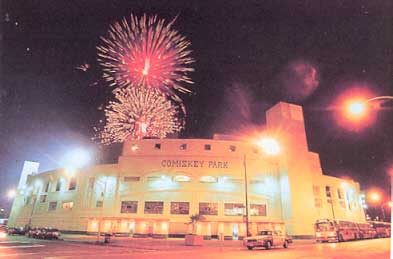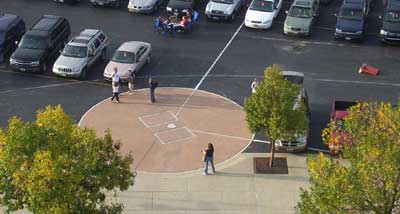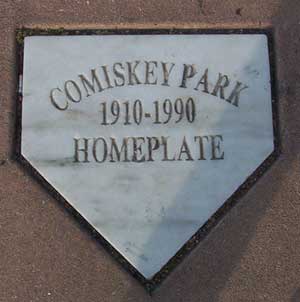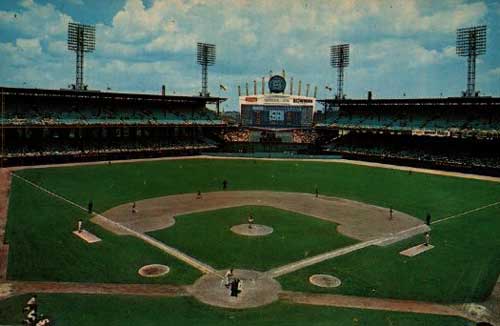
|
Comiskey Park | |||||||
|
Chicago, IL
| Team: Chicago White Sox (AL 1910-90), Chicago American Giants (NAL 1941-50) | Opening Day: July 1, 1910 |
| Capacity: 28,800 (1910) 43,951 (1990) | Dimensions: Foul Lines 363 Power Alleys 382 CF 420 (1910) Foul Lines 347 Power Alleys 382 CF 409 (1986) |
| Surface: Outfield: bluegrass Infield: grass (1910) artificial "Sox Sod" (1969) bluegrass (1976) | Architect: Zachary Taylor Davis, Osborn Engineering |
| Cost: $750,000 | Contractor: George W. Jackson |
| Owner: Chicago White Sox | Closing Day: September 30, 1990 |
| Razed: 1991 |

Memorable Moments:
 |
 |
Charles Comiskey's White Sox, much to his delight, outgrew South Side Park. He decided that he wanted a new concrete and steel stadium. Ground was broken February 10, 1910 and the first game was played there on July 1 of that year. The original configuration consisted of a double decked grandstand that curved around home and went half way to first and third. Two single decked, free standing grandstands continued down the foul lines. There were wooden bleachers in the outfield except for in center where the scoreboard was. From 1926 to 1927, the remaining grandstands were double decked and the bleachers were replaced with double decked grandstands. The scoreboard was moved from center to both left and right fields and uncovered bleachers were added in center. 1947 the center field bleachers were removed to provide a batters backdrop and in 1950 the bullpens were moved from foul territory to just beyond the center field walls. This was pretty much the configuration of the park until it was demolished in 1991.
The (in)famous Bill Veeck became the owner of the White Sox in 1959. He immediately started to add a little charm to the old ballpark. He replaced the left field wall with a picnic area. In 1977, he painted a crazy multi-colored pattern in the upper deck of the left field stands. He told no one, ever, why he did this. Probably his most memorable innovation to Comiskey was the first-in-majors exploding scoreboard installed in 1960. Whenever the White Sox hit a home run, it would make exploding noises, pinwheels would spin, lights would go off, and fireworks would launch. In 1982, a DiamondVision scoreboard was installed, but the old exploding features were retained. Bill Veeck is also famous for possibly one of the worst promotions in baseball history, Disco Demolition Night. On July 12, 1979, in-between games of a double header, fans' disco records were piled in the outfield and lit on fire. People charged the field and it got a little out of control, so much so, that the second game of the double header had to be forfeit.
Veeck wasn't the only colorful character to work out of Comiskey Park. Roger, Gene, and Emil Bossard, the grounds keepers, worked hard for home field advantage. In 1967, the area in front of home plate became known as "Camp Swampy". If a White Sox sinker ball pitcher was on the mound, they would soak that area to slow down the ground balls. However, if the opposing pitcher was a sinker baller, they would mix the dirt with clay and gasoline and burn it to harden it up. They also raised and lowered the opposing pitcher's mounds in the bull pen to throw off their rhythm. Under Eddie Stanky, the manager, the infield grass was cut long in front of the short stop because of his limited range while the grass was cut short in front of the second baseman because he was much better defensively. The grass in the outfield was cut at different levels to either help the line drive hitters or outfielders. When the Sox were a good bunting team, the foul lines were painted wider to keep more balls in play.
A few other interesting notes about the park. The foul lines were actually hoses that were cut, laid flat, and painted white. A corner stone was painted green on St. Patrick's Day in 1910. It remained green until Veeck painted the whole park white in 1960. There were showers in the bleachers in center field. The tradition of the Star Spangled Banner started here in 1918 during the World Series as a patriotic gesture for troops overseas.

The White Sox retired numbers are (in numerical order and the years they were retired):
© 2004-17 Paul Healey. Old pictures © its owners.